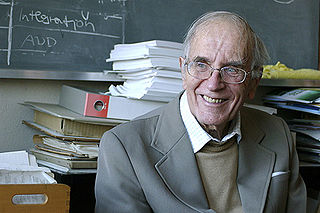
Paul Wild was a Swiss astronomer and director of the Astronomical Institute of the University of Bern, who discovered numerous comets, asteroids and supernovae.
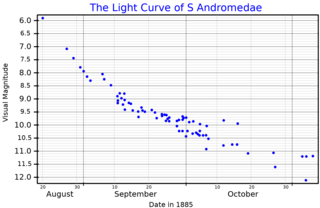
SN 1885A was a supernova in the Andromeda Galaxy, the only one seen in that galaxy so far by astronomers. It was the first supernova ever seen outside the Milky Way, though it was not appreciated at the time how far away it was. It is also known as "Supernova 1885".

SN 2004dj was the brightest supernova since SN 1987A at the time of its discovery.
SN 2005B, the second supernova discovered in 2005, was discovered by amateur astronomer Paul Gray, of Fredericton, New Brunswick, Canada, upon reviewing film shot by fellow amateur astronomer David J. Lane, at his backyard observatory in Stillwater Lake, Nova Scotia, Canada. It was located in the galaxy UGC 11066 in Draco.
The Monte Agliale Supernovae and Asteroid Survey (MASAS) is an offshoot of the Monte Agliale Supernovae Search (MASS), conducted from the Monte Agliale Astronomical Observatory.

The Katzman Automatic Imaging Telescope (KAIT) is an automated telescope used in the search for supernovae.
Robert Owen Evans, OAM was a minister of the Uniting Church in Hazelbrook, New South Wales and an amateur astronomer who holds the record for visual discoveries of supernovae (42).

The known history of supernova observation goes back to 1006 CE. All earlier proposals for supernova observations are speculations with many alternatives.

SN 2006gy was an extremely energetic supernova, also referred to as a hypernova or quark-nova, that was discovered on September 18, 2006. It was first observed by Robert Quimby and P. Mondol, and then studied by several teams of astronomers using facilities that included the Chandra, Lick, and Keck Observatories. In May 2007 NASA and several of the astronomers announced the first detailed analyses of the supernova, describing it as the "brightest stellar explosion ever recorded". In October 2007 Quimby announced that SN 2005ap had broken SN 2006gy's record as the brightest-ever recorded supernova, and several subsequent discoveries are brighter still. Time magazine listed the discovery of SN 2006gy as third in its Top 10 Scientific Discoveries for 2007.
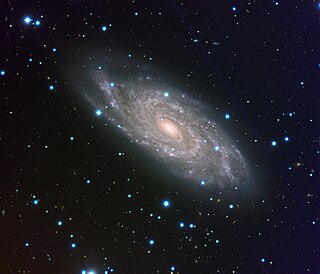
NGC 6118 is a grand design spiral galaxy located 83 million light-years away in the constellation Serpens. It measures roughly 110,000 light-years across; about the same as our own galaxy, the Milky Way. Its shape is classified as "SA(s)cd," meaning that it is unbarred and has several rather loosely wound spiral arms. The large numbers of bright bluish knots are active star-forming regions where some very luminous and young stars can be perceived.

Puckett Observatory is a private astronomical observatory located in the state of Georgia. It is owned and operated by Tim Puckett. Its primary observation goals are the study of comets and the discovery of supernovae. To facilitate the latter goal it sponsors the Puckett Observatory World Supernova Search whose astronomers have discovered 369 supernovae.
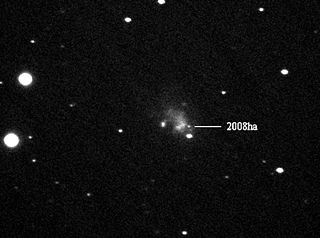
SN 2008ha was a type Ia supernova which was first observed around November 7, 2008 in the galaxy UGC 12682, which lies in the constellation Pegasus at a distance of about 21.3 megaparsecs (69 Mly) from Earth.

SN 1994I is a Type Ic supernova discovered on April 2, 1994 in the Whirlpool Galaxy by amateur astronomers Tim Puckett and Jerry Armstrong of the Atlanta Astronomy Club. Type Ic supernova are a rare type of supernova that result from the explosion of a very massive star that has shed its outer layers of hydrogen and helium. The explosion results in a highly luminous burst of radiation that then dims over the course of weeks or months. SN 1994I was a relatively nearby supernova, and provided an important addition to the then small collection of known Type Ic supernova. Very early images were captured of SN 1994I, as two high school students in Oil City, Pennsylvania serendipitously took images of the Whirlpool Galaxy using the 30-inch telescope at Leuschner Observatory on March 31, 1994, which included SN 1994I just after it began to brighten.
David J. Lane is a Canadian astronomer at Saint Mary's University, the past president of the Royal Astronomical Society of Canada, director of the Burke-Gaffney astronomical observatory, owner of the Abbey-Ridge Observatory, and creator of the planetarium software entitled the Earth Centered Universe. Asteroid 117032 Davidlane is named in his honour, and the asteroid lies in the main asteroid belt between Mars and Jupiter.
SN 2011dh was a supernova in the Whirlpool Galaxy (M51). It was discovered on 31 May 2011, with an apparent magnitude 13.5. and confirmed by several sources, including the Palomar Transient Factory. A candidate progenitor was detected in Hubble Space Telescope images. The progenitor may have been a highly luminous yellow supergiant with an initial mass of 18-24 solar masses. The supernova peaked near apparent magnitude 12.1 on 19 June 2011. Emission spectra indicated that the explosion was a type II supernova, in which a massive star collapses once nuclear fusion has ceased in its core.
Doug Rich is an American amateur astronomer, supernova discoverer, and team leader for the Eagle Hill Supernova Search Project. He is also a former ZYGO optician and telescope maker and now lives in Hampden, Maine, USA. In 1999 he established Rich Observatory and has since discovered 26 extragalactic supernovae.

SN 2014J was a type-Ia supernova in Messier 82 discovered in mid-January 2014. It was the closest type-Ia supernova discovered for 42 years, and none have been closer as of 2018. The supernova was discovered by chance during an undergraduate teaching session at the University of London Observatory. It peaked on 31 January 2014, reaching an apparent magnitude of 10.5. SN 2014J was the subject of an intense observing campaign by professional astronomers and was bright enough to be seen by amateur astronomers.
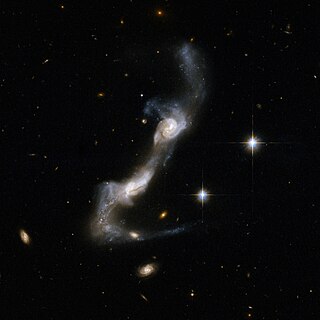
UGC 8335 is a pair of strongly interacting spiral galaxies. They have been distorted by extreme tidal forces, creating prominent tidal tails and a bridge of gas and stars between the galaxies.

NGC 1255 is a barred spiral galaxy approximately 69 million light-years away from Earth in the constellation of Fornax.















